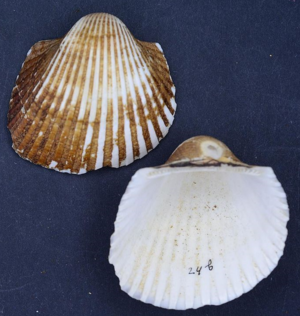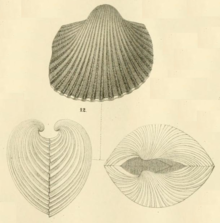Anadara natalensis
| Anadara natalensis | ||||||||||||
|---|---|---|---|---|---|---|---|---|---|---|---|---|

Anadara natalensis |
||||||||||||
| Systematics | ||||||||||||
|
||||||||||||
| Scientific name | ||||||||||||
| Anadara natalensis | ||||||||||||
| ( Krauss , 1848) |
Anadara natalensis is a shell - type from the family of ark shells (Arcidae) in the order of Arcida . The range of the species is the western Indian Ocean including the Persian Gulf and Red Sea . The species is a Lessepsian immigrant in the eastern Mediterranean . It wasdetectedon the coast of Palestine as early as 1935.
features
The clearly unevenly folded, heavily expanded housing has a maximum length of 50 mm (up to 55 mm). It is a little longer than high to even a little higher than long. Krauss gives a ratio of length to height to thickness of 23: 20.5: 18, Kobelt a ratio of 50:46:40. The left valve is larger than the right valve, it protrudes clearly over the right valve on the ventral margin. But it is only slightly unequal, the vertebrae are only slightly in front of the center line of the case. The vertebrae are slightly curled forward. Seen from above, they are far apart. The housing is trapezoidal in outline. The dorsal margin is long and straight. The front end of the dorsal margin merges at a flat angle into the flat rounded front margin. The posterior dorsal edge merges into the very flat or almost straight posterior edge at a less flat to almost right angle. A weakly indicated keel extends from the vertebra to the rear lower slightly angled housing corner. The ventral margin is well rounded.
The ligament lies externally in front of and behind the vertebrae. It shows only a few angular structures and takes up almost the entire area . Up to 50 vertically positioned teeth sit on the narrow, taxodontic lock plate. They are very small in the middle and gradually get larger towards the front and rear ends. With the increase in size, they increasingly diverge outwards.
The aragonitic , dirty white skin is thick, hard-skinned and heavy. The ornamentation consists of 27 to 30 smooth, radial ribs, the spaces between the ribs being slightly narrower than the ribs themselves. The ribs are indistinctly furrowed across. They are angular on the front and middle part of the housing, towards the rear part of the housing they become increasingly round. The brown periostracum consists of fine lamellae or scales. The inner edge of the housing is correspondingly strongly notched with the outer ribs. The inner side of the case is snow white.
Geographical distribution, habitat and way of life
The distribution area of Anadara natalensis extends from South Africa , along the coast of East Africa to the Red Sea, around the Arabian Peninsula to the Persian Gulf. It is also found in the waters around Madagascar and Mauritius .
In 1935 it was first detected on the coast of what was then Palestine. Today the distribution area extends in the eastern Mediterranean to south-eastern Turkey .
The animals prefer muddy or sandy-muddy soils in shallow water, in the Mediterranean up to about 55 meters water depth.
Taxonomy
The taxon was first published in 1848 by Ferdinand Krauss as Arca natalensis . It is now generally accepted as belonging to the genus Anadara Gray, 1857. A more recent synonym is Scapharca jickelii Jickeli, 1882.
literature
- Peter Graham Oliver, Kevin Thomas (pictures): Bivalved seashells of the Red Sea. 330 pp., Wiesbaden, Hemmen et al. a., 1992 ISBN 3-925919-08-2 (p. 34)
- Argyro Zenetos, Serge Gofas, Giovanni Russo, José Templado: CIESM Atlas of Exotic Species in the Mediterranean. Vol.3 Mollusca. CIESM (Frédéric Briand, ed.), Monaco, 2003 ISBN 92-990003-3-6 (p. 216/17)
Individual evidence
- ^ A b Ferdinand Krauss: The South African mollusks; a contribution to the knowledge of the mollusks of the Cape and Natalland and their geographical distribution, with description and illustration of the new species. 140 p., Stuttgart, Ebner & Seubert, 1848. Online at www.biodiversitylibrary.org (p. 17) plate 1
- ^ DG Steyn, Markus Lussi: Marine Shells of South Africa: An Illustrated Collector's Guide to Beached Shells. 264 p., Ekogilde Publishers, Hartebeespoort, 1998 ISBN 0-9583889-5-4 (p. 198/99)
- ^ Wilhelm Kobelt: The genus Arca L. In illustrations after nature with descriptions. Systematic Conchylia Cabinet by Martini and Chemnitz, 8 (2): 1-238, Nuremberg 1891 Online at www.biodiversitylibrary.org (p. 129), plate 1 .
- ^ Philippe Dautzenberg: Contribution à l'étude de la faune de Madagascar: Mollusca marina testacea . Faune des colonies françaises, III (fasc. 4). Pp. 321–636, Société d'Editions géographiques, maritimes et coloniales, Paris 1929.
- ↑ a b MolluscaBase: Anadara natalensis (Krauss, 1848)
